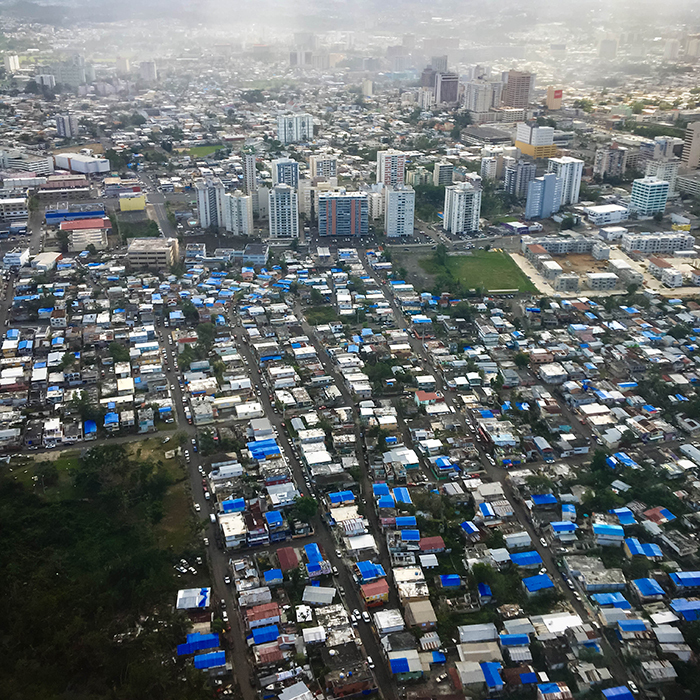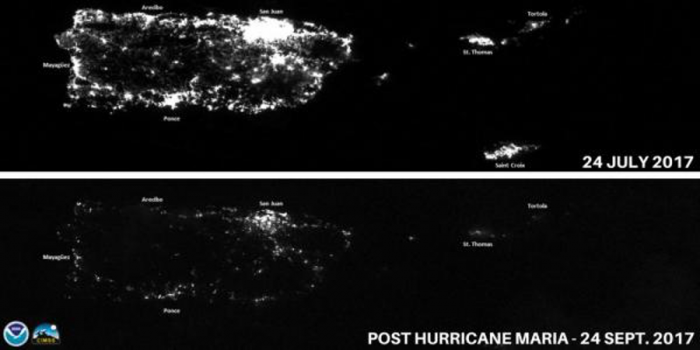Case Study: Puerto Rico and Hurricane Maria
Differential response and recovery times across U.S. communities hit by 2017 storms
The 2017 Atlantic hurricane season went down in history as having the most named storms since 2005. In 2005 there were 28 named storms and 15 of them becoming hurricanes, while in 2017 there were 17 named storms and 10 of these became hurricanes. The three most notable out of these storms – Harvey (landfall on August 25 in Texas), Irma (Landfall September 10 in Florida) and Maria, (Landfall on September 20 in Puerto Rico) followed in close succession and broke records for their intensity in the places they impacted.
The U.S. federal government, represented by FEMA, responded by supplying funds, aid, supplies, and personnel following the storm impacts in each of these places, but there were many concerns raised about the disparity in response after Maria in Puerto Rico, a U.S. territory, compared to the mainland states impacted by Irma and Harvey. So, what really happened following Hurricane Maria in Puerto Rico? Were the Puerto Rican people, who are American citizens, neglected by the federal government following this major natural disaster? Let’s take a closer look at the impacts of and responses to Hurricane Maria in Puerto Rico.Maria achieved its peak intensity over the eastern Caribbean and made landfall in Yabucao, southeastern Puerto Rico as a strong category 4 storm, where winds of 175 mph (280 km/h) were recorded. It was the first Category 4 hurricane to directly impact the island in 85 years, and it caused widespread damage that was felt for months, if not years.
Prior to Maria’s landfall, hundreds of shelters were set up, and evacuation orders were given. An uptick in travel from the island just before the storm was indicative of the numbers of people fleeing to the U.S. mainland to stay with family.
Compounding the impacts of Maria on the island was the damage from Category 5 Hurricane Irma just 2 weeks prior, especially to the electrical grid, which was crippled by Maria, leaving all 3.4 million residents without electricity for an extended period. Six months after the storm, many were still without power and had not been able to repair their houses. In fact, the combined impacts of hurricanes Irma and Maria resulted in Puerto Rico Electrical Power Authority (PREPA) filing for bankruptcy. Imagine all the functions that are impossible without power, besides the misery of living in a tropical climate without any means to refrigerate food or enjoy air-conditioning. All means of modern communication are impossible because cell phone towers are one of the first things to be destroyed by the high winds of a major storm.

The number of people killed by Hurricane Maria proved challenging to count. An initial number of 65 deaths directly attributable to the storm was officially recorded by the federal government. This number did not account for those whose deaths were from indirect causes linked to the hurricane, due to deprivation caused by things like lack of power and medical services and a multitude of other causes during the response and recovery phases. Six months after Maria’s landfall, an estimate of 2,975 indirect deaths was made by examining the mortality rate for that time period compared to the same period during previous years. The sensitive populations – the elderly, the very young, and the sick - suffer the most in the immediate aftermath of a disaster like a hurricane, and it is among these groups that the most deaths occurred in Maria.

Residents of the U.S. territory were able to apply for aid through FEMA, but reports indicated that supplies moved slowly to destinations, hampering recovery. In November 2017, two months after the storm, 60% were still without power and perhaps 20% without water, so that many had to collect water from streams and rainwater. Many stories in the media at the six-month mark highlighted the misery of a slow recovery. There was a lack of adequate infrastructure repair, medical services, and the simple availability of supplies throughout this time, although many charity organizations supported the effort.
An objective study by BMJ Global Health: Quantifying inequities in US federal response to hurricane disaster in Texas and Florida compared with Puerto Rico, investigated the question of whether the federal response to Hurricane Maria in Puerto Rico was significantly smaller and slower than the responses to Hurricane Irma in Florida and Hurricane Harvey in Texas. Their conclusion was that the response to Maria was indeed lacking and did not align with the storm severity or the needs of the affected communities. They note that “Increases in mortality and adverse health outcomes due to differentiated disaster response and recovery efforts may promote inequity among populations that receive less aid.” In other words, Puerto Rico did not receive the same level of aid as Texas and Florida after Harvey and Irma respectively, and the people of Puerto Rico suffered as a result. They go on to suggest reasons for this in this way: “There may be many different reasons why the federal response varied in each case. Ability to access the affected area based on geography and distance, existing infrastructure aiding or acting as barriers to response efforts, disaster fatigue, as well as issues of racial bias and perceptions of differential citizenship all may have affected the appropriation and delivery of resources and funding to affected areas in each hurricane. Different mechanisms for the varied responses may be more or less justified. However, what cannot be contested is that the responses were in fact different across critical time points, and these differences have serious consequences for acute and long-term health outcomes and recovery efforts.”
The data in the report clearly show a disparity in the amount of aid received and the time taken for aid to be received. This article highlights the critical nature of getting aid to its target in a timely manner. Slow responses lead to serious negative outcomes, as Puerto Rican residents can attest. Be sure to read Echoes of Katrina: Post-Maria Public Health Threats and Trauma.
